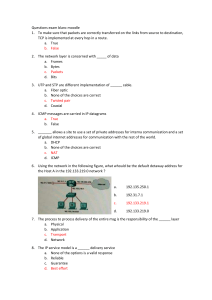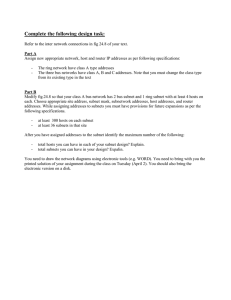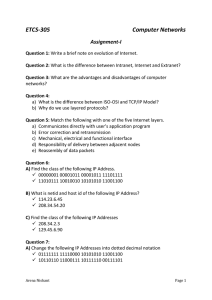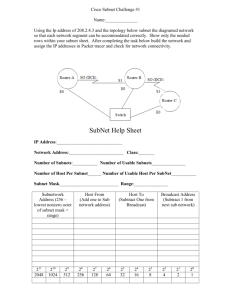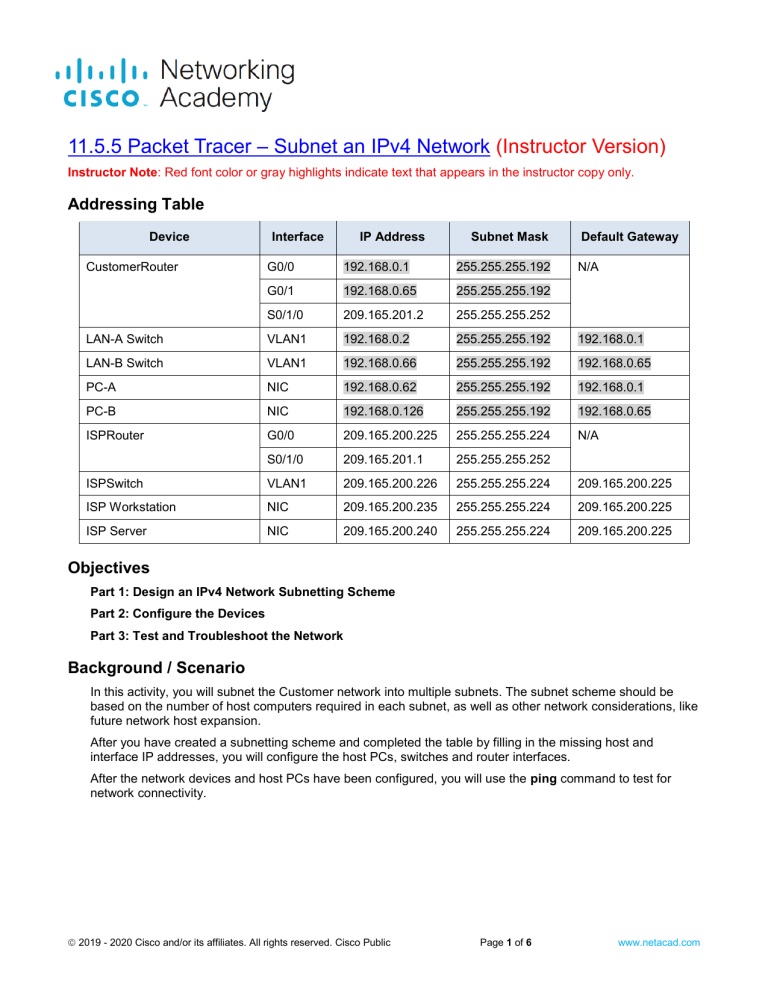
11.5.5 Packet Tracer – Subnet an IPv4 Network (Instructor Version) Instructor Note: Red font color or gray highlights indicate text that appears in the instructor copy only. Addressing Table Device Interface IP Address Subnet Mask Default Gateway CustomerRouter G0/0 192.168.0.1 255.255.255.192 N/A CustomerRouter G0/1 192.168.0.65 255.255.255.192 N/A CustomerRouter S0/1/0 209.165.201.2 255.255.255.252 N/A LAN-A Switch VLAN1 192.168.0.2 255.255.255.192 192.168.0.1 LAN-B Switch VLAN1 192.168.0.66 255.255.255.192 192.168.0.65 PC-A NIC 192.168.0.62 255.255.255.192 192.168.0.1 PC-B NIC 192.168.0.126 255.255.255.192 192.168.0.65 ISPRouter G0/0 209.165.200.225 255.255.255.224 N/A ISPRouter S0/1/0 209.165.201.1 255.255.255.252 N/A ISPSwitch VLAN1 209.165.200.226 255.255.255.224 209.165.200.225 ISP Workstation NIC 209.165.200.235 255.255.255.224 209.165.200.225 ISP Server NIC 209.165.200.240 255.255.255.224 209.165.200.225 Objectives Part 1: Design an IPv4 Network Subnetting Scheme Part 2: Configure the Devices Part 3: Test and Troubleshoot the Network Background / Scenario In this activity, you will subnet the Customer network into multiple subnets. The subnet scheme should be based on the number of host computers required in each subnet, as well as other network considerations, like future network host expansion. After you have created a subnetting scheme and completed the table by filling in the missing host and interface IP addresses, you will configure the host PCs, switches and router interfaces. After the network devices and host PCs have been configured, you will use the ping command to test for network connectivity. 2019 - 2020 Cisco and/or its affiliates. All rights reserved. Cisco Public Page 1 of 6 www.netacad.com Packet Tracer – Subnet an IPv4 Network Instructions Part 1: Subnet the Assigned Network Step 1: Create a subnetting scheme that meets the required number of subnets and required number of host addresses. In this scenario, you are a network technician assigned to install a new network for a customer. You must create multiple subnets out of the 192.168.0.0/24 network address space to meet the following requirements: a. The first subnet is the LAN-A network. You need a minimum of 50 host IP addresses. b. The second subnet is the LAN-B network. You need a minimum of 40 host IP addresses. c. You also need at least two additional unused subnets for future network expansion. Note: Variable length subnet masks will not be used. All of the device subnet masks should be the same length. d. Answer the following questions to help create a subnetting scheme that meets the stated network requirements: Questions: How many host addresses are needed in the largest required subnet? Type your answers here. 50 What is the minimum number of subnets required? Type your answers here. The requirements stated above specify two company networks plus two additional networks for future expansion. So, the answer is a minimum of four networks. The network that you are tasked to subnet is 192.168.0.0/24. What is the /24 subnet mask in binary? Type your answers here. 1111111.11111111.11111111.00000000 e. The subnet mask is made up of two portions, the network portion, and the host portion. This is represented in the binary by the ones and the zeros in the subnet mask. Questions: In the network mask, what do the ones represent? Type your answers here. The ones represent the network portion. In the network mask, what do the zeros represent? Type your answers here. The zeroes represent the host portion. f. To subnet a network, bits from the host portion of the original network mask are changed into subnet bits. The number of subnet bits defines the number of subnets. Questions: Given each of the possible subnet masks depicted in the following binary format, how many subnets and how many hosts are created in each example? Hint: Remember that the number of host bits (to the power of 2) defines the number of hosts per subnet (minus 2), and the number of subnet bits (to the power of two) defines the number of subnets. The subnet bits (shown in bold) are the bits that have been borrowed beyond the original network mask of /24. The /24 is the prefix notation and corresponds to a dotted decimal mask of 255.255.255.0. 2019 - 2020 Cisco and/or its affiliates. All rights reserved. Cisco Public Page 2 of 6 www.netacad.com Packet Tracer – Subnet an IPv4 Network 1) (/25) 11111111.11111111.11111111.10000000 Dotted decimal subnet mask equivalent: Type your answers here. 255.255.255.128 Number of subnets? Number of hosts? Type your answers here. Two subnets (2^1) and 128 hosts (2^7) – 2 = 126 hosts per subnet 2) (/26) 11111111.11111111.11111111.11000000 Dotted decimal subnet mask equivalent: Type your answers here. 255.255.255.192 Number of subnets? Number of hosts? Type your answers here. Four subnets (2^2) and 64 hosts (2^6) – 2 = 62 hosts per subnet 3) (/27) 11111111.11111111.11111111.11100000 Dotted decimal subnet mask equivalent: Type yor answers here. 255.255.255.224 Number of subnets? Number of hosts? Type your answers here. Eight subnets (2^3) and 32 hosts (2^5) – 2 = 30 hosts per subnet 4) (/28) 11111111.11111111.11111111.11110000 Dotted decimal subnet mask equivalent: Type your answers here. 255.255.255.240 Number of subnets? Number of hosts? Type your answers here. Sixteen subnets (2^4) and 16 hosts (2^4) – 2 = 14 hosts per subnet 5) (/29) 11111111.11111111.11111111.11111000 Dotted decimal subnet mask equivalent: Type your answers here. 255.255.255.248 Number of subnets? Number of hosts? Type your answers here. Thirty two subnets (2^5) and 8 hosts (2^3) – 2 = 6 hosts per subnet 6) (/30) 11111111.11111111.11111111.11111100 Dotted decimal subnet mask equivalent: 2019 - 2020 Cisco and/or its affiliates. All rights reserved. Cisco Public Page 3 of 6 www.netacad.com Packet Tracer – Subnet an IPv4 Network Type your answers here. 255.255.255.252 Number of subnets? Number of hosts? Type your answers here. Sixty four subnets (2^6) and 4 hosts (2^2) – 2 = 2 hosts per subnet Considering your answers above, which subnet masks meet the required number of minimum host addresses? Type your answers here. /25, /26 Considering your answers above, which subnet masks meets the minimum number of subnets required? Type your answers here. /26, /27, /28, /29, /30 will give the required number of subnets. Considering your answers above, which subnet mask meets both the required minimum number of hosts and the minimum number of subnets required? Type your answers here. /26 will give you the four subnets that are required, and 62 hosts per subnet, which is greater than the 50 hosts required for the first subnet. When you have determined which subnet mask meets all of the stated network requirements, derive each of the subnets. List the subnets from first to last in the table. Remember that the first subnet is 192.168.0.0 with the chosen subnet mask. Subnet Address Prefix Subnet Mask 192.168.0.0 /26 255.255.255.192 192.168.0.64 /26 255.255.255.192 192.168.0.128 /26 255.255.255.192 192.168.0.192 /26 255.255.255.192 Step 2: Fill in the missing IP addresses in the Addressing Table Assign IP addresses based on the following criteria: Use the ISP Network settings as an example. a. Assign the first subnet to LAN-A. 1) Use the first host address for the CustomerRouter interface connected to LAN-A switch. 2) Use the second host address for the LAN-A switch. Make sure to assign a default gateway address for the switch. 3) Use the last host address for PC-A. Make sure to assign a default gateway address for the PC. b. Assign the second subnet to LAN-B. 1) Use the first host address for the CustomerRouter interface connected to LAN-B switch. 2) Use the second host address for the LAN-B switch. Make sure to assign a default gateway address for the switch. 3) Use the last host address for PC-B. Make sure to assign a default gateway address for the PC. 2019 - 2020 Cisco and/or its affiliates. All rights reserved. Cisco Public Page 4 of 6 www.netacad.com Packet Tracer – Subnet an IPv4 Network Part 2: Configure the Devices Configure basic settings on the PCs, switches, and router. Refer to the Addressing Table for device names and address information. Step 1: Configure CustomerRouter. a. Set the enable secret password on CustomerRouter to Class123 b. Set the console login password to Cisco123. c. Configure CustomerRouter as the hostname for the router. d. Configure the G0/0 and G0/1 interfaces with IP addresses and subnet masks, and then enable them. e. Save the running configuration to the startup configuration file. Step 2: Configure the two customer LAN switches. Configure the IP addresses on interface VLAN 1 on the two customer LAN switches. Make sure to configure the correct default gateway on each switch. Step 3: Configure the PC interfaces. Configure the IP address, subnet mask, and default gateway settings on PC-A and PC-B. Part 3: Test and Troubleshoot the Network In Part 3, you will use the ping command to test network connectivity. a. Determine if PC-A can communicate with its default gateway. Do you get a reply? Yes b. Determine if PC-B can communicate with its default gateway. Do you get a reply? Yes c. Determine if PC-A can communicate with PC-B. Do you get a reply? Yes If you answered “no” to any of the preceding questions, then you should go back and check your IP address and subnet mask configurations, and ensure that the default gateways have been correctly configured on PCA and PC-B. End of Document Device Configs CustomerRouter enable configure terminal hostname CustomerRouter enable secret Class123 line con 0 password Cisco123 login interface GigabitEthernet0/0 ip address 192.168.0.1 255.255.255.192 no shutdown interface GigabitEthernet0/1 2019 - 2020 Cisco and/or its affiliates. All rights reserved. Cisco Public Page 5 of 6 www.netacad.com Packet Tracer – Subnet an IPv4 Network ip address 192.168.0.65 255.255.255.192 no shutdown interface Serial0/1/0 ip address 209.165.201.2 255.255.255.252 no shutdown end LAN-A enable configure terminal interface Vlan1 ip address 192.168.0.2 255.255.255.192 no shutdown ip default-gateway 192.168.0.1 end LAN-B enable configure terminal interface Vlan1 ip address 192.168.0.66 255.255.255.192 no shutdown ip default-gateway 192.168.0.65 end PC-A IP address: 192.168.0.63 /26 Default gateway: 192.168.0.1 PC-B IP address: 192.168.0.126 /26 Default gateway: 192.168.0.65 2019 - 2020 Cisco and/or its affiliates. All rights reserved. Cisco Public Page 6 of 6 www.netacad.com
